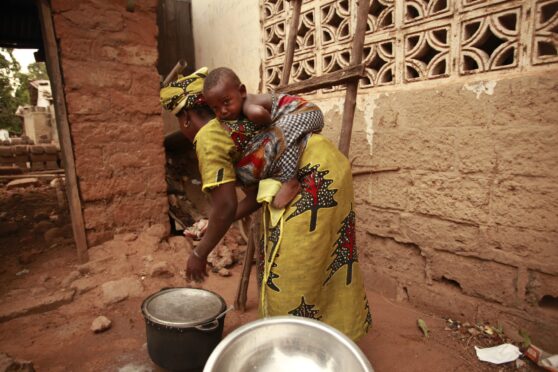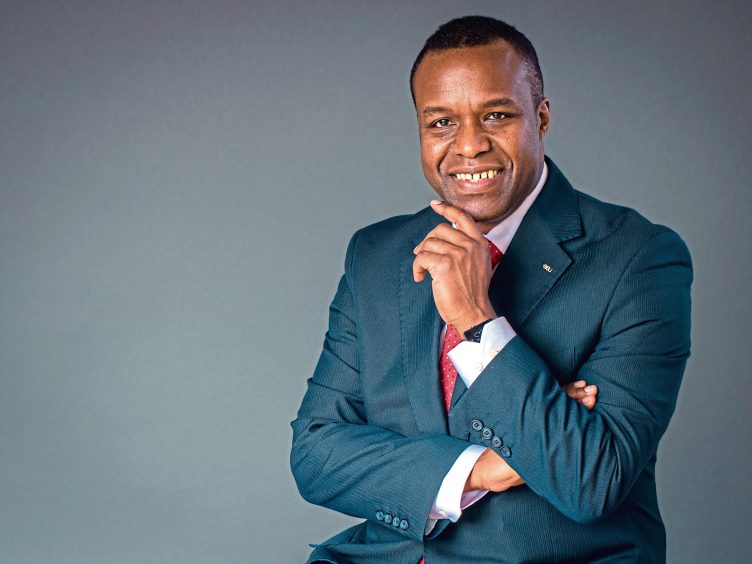
In Africa where maternity care can be a matter of luck, an expectant mother is said to have one foot in the grave.
The harrowing signpost at a district hospital points to mortuary, maternity and paediatrics sited in the same corner. It reveals the harrowing reality facing mothers.
While it echoes shades of the past, the reality of death in childbirth is still common today, says Aberdeen University surgeon Professor James N’Dow. In The Gambia, where he grew up, the number of mothers dying in labour is 289 for every 100,000 births. In the UK that figure is 13 per 100,000.
Professor N’Dow is heading up the Scottish arm of an international operation to save these mothers and babies.
The Horizons Trust charity founded by him two decades ago has delivered clean water, clinics, vital medical training to Gambian doctors, midwives and basics like new sinks, toilets and other lifesaving essentials.
Working along with the Gambian government and others, they are helping to reduce the numbers of mothers and babies dying during birth.
Professor N’Dow is driven by his childhood growing up the youngest of five children to older parents in the country’s capital, Banjul.
He says there was little money for university fees, however a scholarship from the British Council in 1985 catapulted him from a laboratory job in the Medical Research Unit in The Gambia to Aberdeen University to study medicine. It was a one-way ticket to the UK.
“I hugely appreciate the opportunity I got to become a doctor and surgeon and need to use everything I have gained to improve the health of the people I left behind in Gambia,” he said.
“Compared with countries like the UK and most other developed countries, The Gambia has a dreadful number of women dying in childbirth.
“The reality of some public hospitals in some parts of Africa is that lights can fail during surgery and doctors can find themselves paying out of their pockets to top up the supply. Babies can be also delivered by the torchlight of a mobile phone. The poor walk for miles to see a doctor or nurse with no expectation of quality of care and they often arrive in the extremes of dying… circumstances you will never see in the UK.
“Women with continence injuries after childbirth can go untreated and are ostracised by others who accuse them of being unclean. Working to cope with this burden of care understandably makes doctors, nurses and other health staff feel overwhelmed and demoralised.”
It is not hard to see why their colleagues in other countries feel the need to help.
He said: “The Horizons Trust is supported with doctors and financial support from other countries and we all have a common belief and mission that no pregnant mother in any part of the world should ever fear bleeding to death in childbirth.
“Sadly, one in three women in low-income countries who die during childbirth bleed to death and the impact on their families can be devastating for generations.”
He points to its training programme which, over the past two years, has been focused on emergency maternal and obstetric care. “It has trained midwives, obstetricians and anaesthetists who are vital for anaesthesia sedation and pain relief in Caesarean section deliveries and complicated deliveries.
“This training programme works in parallel with smart pods at Kanifing General Hospital, 15 minutes from The Gambia’s coastal capital of Banjul.
“These smart pods are innovative mobile theatres with accompanying anaesthetic room and recovery area for mothers after they deliver their babies.
“The pods are the first of their kind in west Africa and are already saving mothers’ lives.”
Mobile lifesaving theatres have another Scottish connection which stretches back almost 90 years earlier.
Scots Canadian war surgeon Norman Bethune used them to save the lives of Chinese casualties in the Second Sino-Japanese War.
He transported a mobile theatre, fitted over the backs of two donkeys, to battle fronts.
Within a few months he had treated more than 500 wounded casualties back to health, say reports of the time. Dr Bethune died from sepsis in 1939.
While modern protective surgical gowns and other equipment spare today’s doctors this fate, the battle to save lives is still relevant.
Professor N’Dow acknowledges the collaboration of supporters across continents and time zones. We couldn’t and we don’t do this work alone,” he added. “The smart pods are a result of collaboration and co-operation of others committed to saving mothers and babies.
“These include the Ministry of Health in The Gambia and the team at Kanifing General Hospital who have proven themselves to be outstanding and inspiring over the years.”
The theatre pods bringing emergency mobile units to mothers in distress were designed by Baylor College of Medicine in Houston, Texas. Funding came from Trini Mendenhall whose foundation ploughed money into the lifesaving mission.
More than 3,600 miles further south in Zambia, another Scottish charity, the Scottish Catholic International Relief Fund (SCIAF), is working to help mothers and babies through supporting a new clinic.
Mums give birth in safer places with secure roofs and solar-powered light and clean, safe medical equipment. The work to save mothers and babies in developing countries goes on.

Enjoy the convenience of having The Sunday Post delivered as a digital ePaper straight to your smartphone, tablet or computer.
Subscribe for only £5.49 a month and enjoy all the benefits of the printed paper as a digital replica.
Subscribe © Edwin van Wijk / RGU
© Edwin van Wijk / RGU